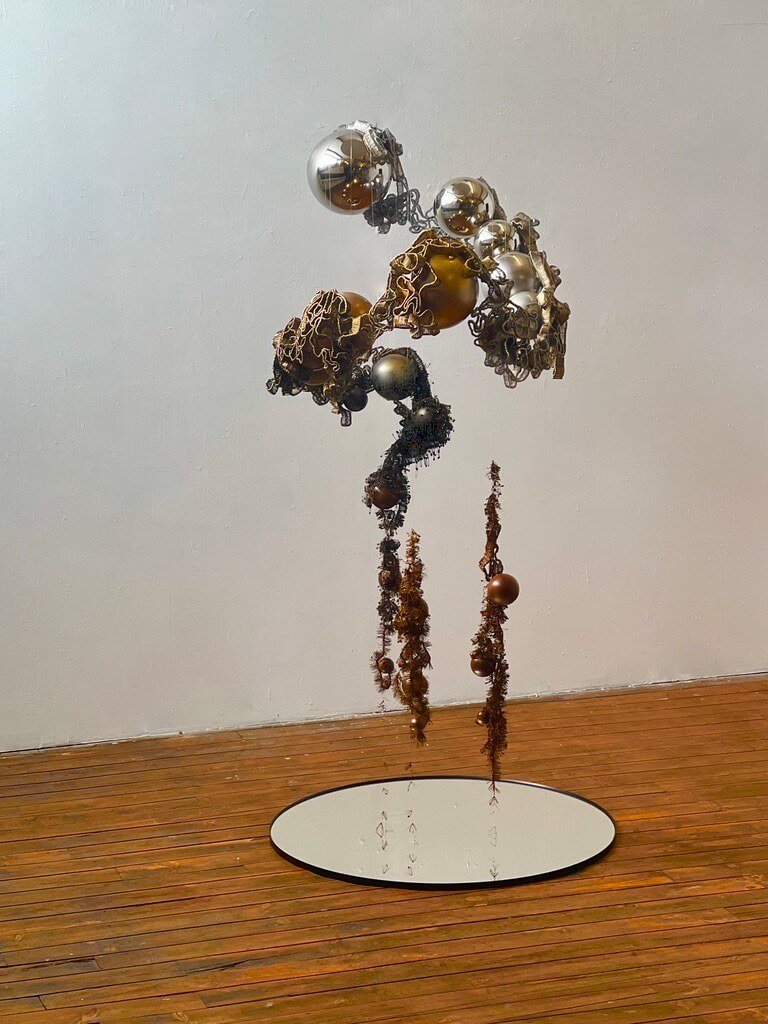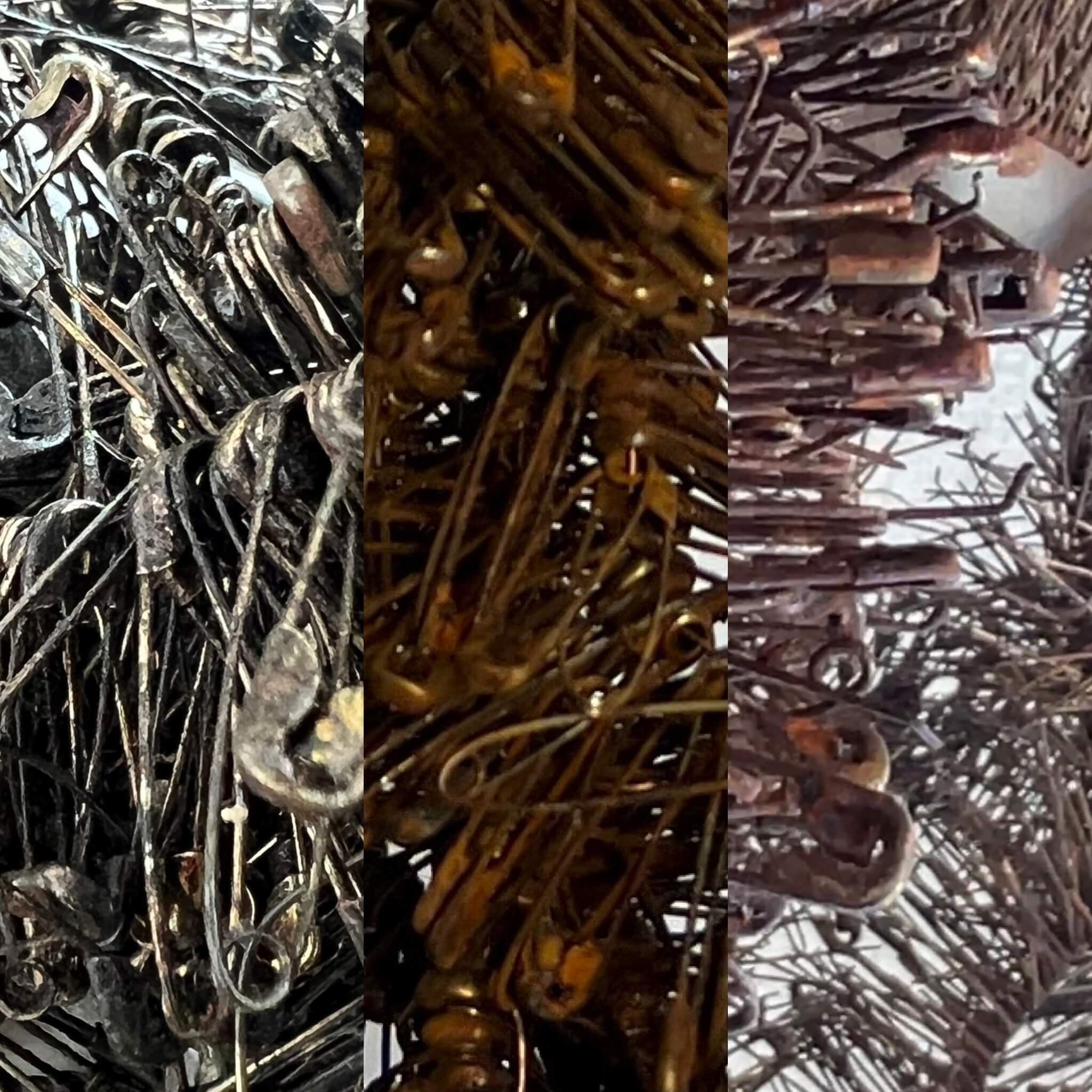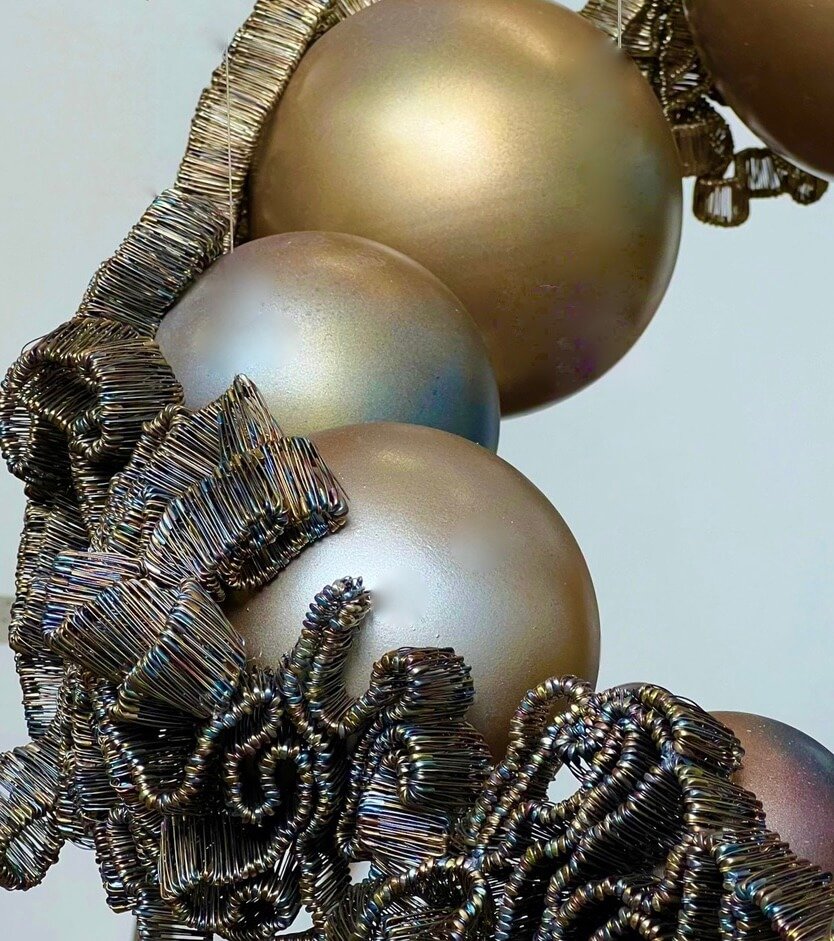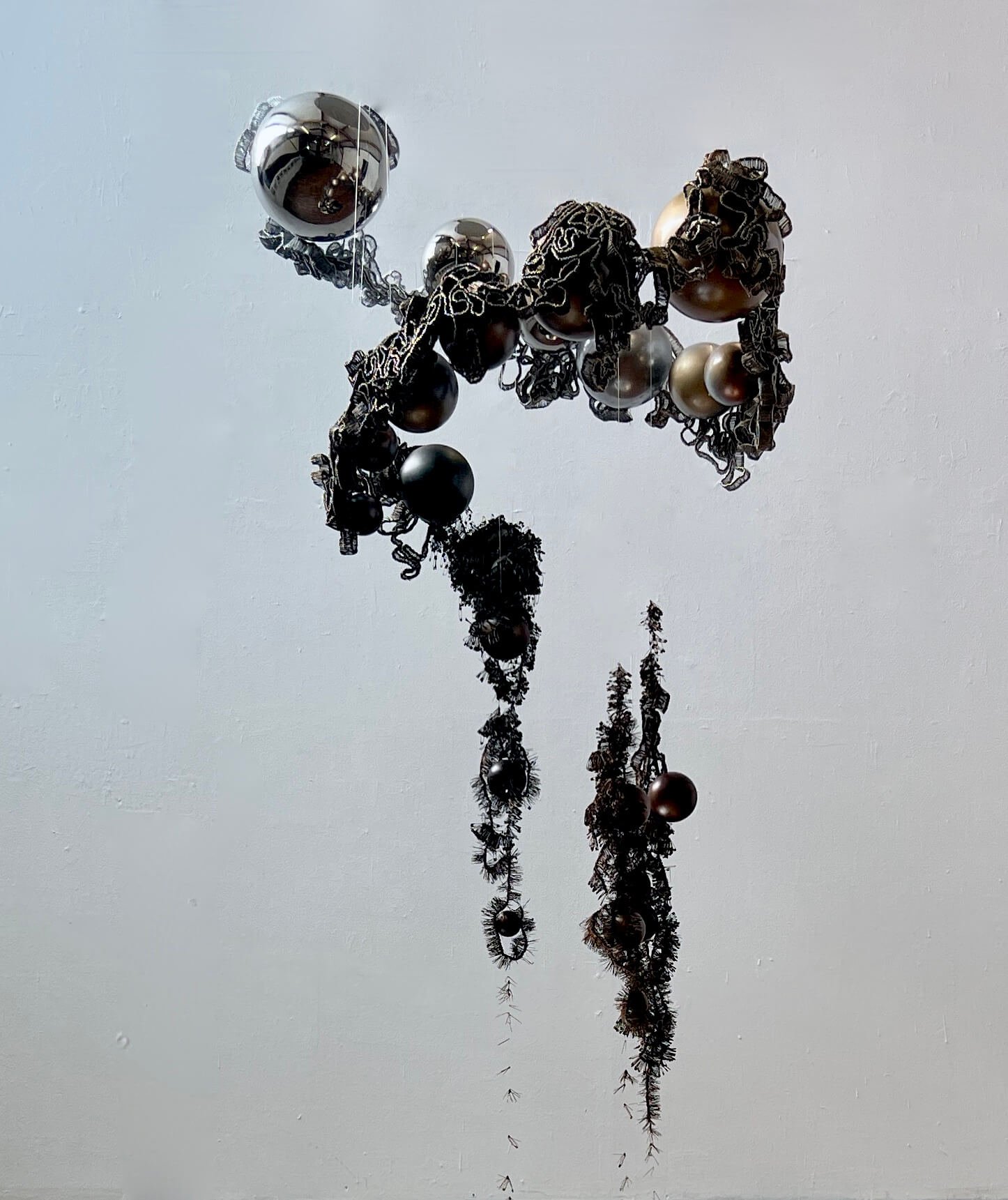Karin Jolly
"I explore the texture of life, the realm where strength and vulnerability intertwine."
– Karin Jolly
Jolly’s work invites exploration of the intersections between the familiar and the unexpected, traditional craft and contemporary form, and strength and vulnerability. At the core of Jolly's artistic philosophy is a deep appreciation for what she refers to as "the texture of life." She believes that the richness of the human experience is reflected in even the simplest materials, such as human hair, limescale, bacteria, and, most recently, safety pins in her piece The Nature of Love. Through her artistry, Jolly encourages us to contemplate the narratives we attach to these humble materials while unveiling unexpected beauty and the profound impact of reimagining the ordinary.
In Jolly's artistic realm, every element serves a purpose in the narratives she weaves. From her choice of materials to her innovative use of traditional craft techniques, her meticulous execution and craftsmanship, each layer contributes to her dialogue. Jolly aptly describes this process as "preloading the conversation: My artworks are the artifacts of these conversations."
"When the familiar becomes transformed into something unforeseeable, it is here that we find new possibilities. When perceptions are challenged and enough people agree to a particular view, the fabric of society starts to shift!"
https://karinjolly.com/
What initially drew you to art?
Art is my lighthouse; in my darkness, it guides me through the storms of life, and its light dances with my shadows.
In the beginning, there was darkness. I am one of three children, and our early life was filled with abuse and extreme violence from our stepmother. I always felt a sense of "otherness" that made me feel disconnected. I was the loner in the corner of the playground, the "ginger freak." I lived with constant fear and shame, believing there was something about me that, if others saw or felt it, would make me the target of ridicule. I felt unworthy of connection, as if I would unravel publicly. Living with fear and shame dominates all aspects of life and brings with it an incredible weight and darkness.
My first light and its shadows.
When I became a teenager, I met the painter Robert Lenkiewicz, and it changed everything. He became the light in my life, the window through which I now viewed the world, and light flooded into my darkness. His passion for art, his obsession with rare books, and his focus on me were intoxicating. We would spend our evenings at St. Saviour Church, which had been converted into one of his libraries and studios. He would read to me from rare art history books and ancient philosophical manuscripts. During the day, classical music floated around the studio, and we discussed art and philosophy as he painted me. I became his muse. He had a quiet but regal demeanor and would say, "To be an artist requires total focus, commitment, and diligence." I listened intently. I was young and impressionable, thirsty for connection, and he presented me with my first cup of knowledge and culture. Our relationship was intense. I revered him, and he nurtured and studied me. Art, with an undertone of philosophy, coursed through my veins like a drug, and I was addicted!
However, the more he taught me, the less available I became to him. I needed to explore the possibilities of this new world. When he realized I was leaving, he offered to set me up in a private studio in Plymouth. He would finance everything, and I would work there every day while he visited. No one else was to know or be involved. He had made it impossible for me to fulfill his artist's indulgence, rather than pursuing my own. His mantra of the romantic artistic existence—the lone artist with no room for relationships or distractions—was evident. Looking back, I see that he wanted to exclusively possess me, while he indulged in multiple relationships, all in the name of "his art." A duplicitous morality. I wanted to venture out into the world. I was, after all, a wide-eyed, eager young girl full of optimism, limitlessness, and blissfully unaware of my freedom or mortality.
So, I left. Life was now an amazing adventure, and I wanted to be part of it. Despite all of this, I am grateful for having met him, as he provided me with an independence of thought that liberated me mentally, physically, and spiritually. We remained friends until his death.
How have elements of your personal journey influenced your artistic expression?
I've come to realize that true artistic expression stems from authenticity and courage—the courage to embrace truth and our imperfections, which I believe is a universal human condition. Honest work can create connection and effect change. This is my experience as an artist and as a mother—the lens through which I view life. Creativity is born from vulnerability. For the first time, I want to share my story, my vulnerability.
I went out into the world with the assumption that I could have it all. The hedonistic 1980s fueled my expectation of achieving a successful career with a well-adjusted family, all fitting perfectly around my business. Perhaps the turning point came after I married my soulmate, and with unrestrained enthusiasm, I launched myself into family life. The idea of the mother as the efficient, sole domestic warrior, focused only on her children, is systemically indoctrinated. I was determined to be the perfect mother I never had. However, with the birth of my first child, reality hit me hard. The idyllic, serene scenes of motherhood I had imagined were replaced by bone-deep exhaustion and overwhelming vulnerability. I felt alone and isolated, convinced that everyone else found parenting easy. I felt the need to sacrifice everything—my mental, physical, and emotional energy, my identity, and all my aspirations—to be a good mother. I now know that it takes courage, confidence, and experience to realize that the ideal of the perfect mother is unobtainable and unrealistic. I didn't gain this perspective until much later in life.
As a result of this idealization, my marriage ran into difficulties, and my husband and I split up. I was broken, crying on the bathroom floor for days. Then, one day, my friends Horst and Sue took me to the home of painter Inge Clayton. After feeding me and talking with me, Inge gently took me to her studio, locked me in, and told me to "Paint!" I stayed there for the rest of the day. Inge brought me drinks and snacks, offering gentle encouragement to keep going. I had found a channel that breathed life into my soul, a way to communicate. The next morning, I woke with a new perspective. Art was my lighthouse again.
What about your practice do you find the most fulfilling and/or energizing?
From a personal perspective, I have found that it is vital for me to have the time to study, contemplate, and create. The sense of connection, flow, and unity that I experience while working is unparalleled. Few feelings surpass the opportunity to pour yourself into something that connects your mind, body, and soul. Leaving the studio after finishing a piece, exhausted and at peace, allows you to breathe from a deep place within. I feel connected and understood through this language of materials, and in those moments, nothing else exists. It creates a profound sense of wholeness. I now understand how families can become neglected—not out of neglect, but as a result of the passion for art.
What started as an investigation into my own identity and the search for connection and belonging has grown over the years. I still use my studio to process and interpret life. It has become a starting point for my work: I aim to express authentic emotion to encourage compassion and acceptance, creating a conduit for connection.
In 2023, I had the privilege of exhibiting at The Museum of Contemporary Art in Perpignan, France. I created The Nature of Love, a large piece of contemporary sculpture inspired by Roland Barthes' A Lover’s Discourse. The sculpture unfolds in a spiraling motion, reflecting the narrative of love. Initially, everything is magnified—an exaggerated spectacle of love's radiant beauty. But the work eventually undergoes a metamorphosis, deteriorating and decomposing, representing the act of falling out of love. Made of stainless-steel spheres and 80,000 safety pins, the safety pins symbolize both strength and vulnerability in love's words and actions. Underneath, a large mirror allows viewers to see the process in reverse, offering a chance to witness the opportunity to fall back in love.
At the museum, a lady asked me to explain the work. She shared that her husband, the love of her life, had died, and that was the end of love for her. I asked her to tell me about her life. She recounted their love story, but after his death, she did nothing for many years. Then, she returned to college to study art, and now she visits galleries regularly, finding joy in it. I suggested that perhaps she had fallen back in love with herself. She grabbed my arm, tears in her eyes, and said, "Perhaps, I did!" I never knew her name, but this experience will stay with me forever. I want to create art that does that!
Tell us about your experience getting to where you are now. What has been the most important thing you’ve learned?
After my marriage broke up, I enrolled in an art foundation course at Barnet College and discovered the sculpture workshops. A day trip to the Turner Prize in 1998 opened my eyes. Cathy De Monchaux’s visionary use of simple materials revealed a richness in language I hadn't encountered before. Her work juxtaposed soft velvet, jean zips, steel bolts, and metal sheeting, exploring the explicit and chaste, the beautiful and grotesque, the seductive and repulsive.
I quickly realized that the power of materials was integral to creating pieces that stir the viewer’s emotion. I began to experiment with objects around me—objects I could find in my everyday life. I wanted to bring new perspectives to those objects and use them to shape my art.
Since then, I've embraced the fluidity of life, accepting that art is not a destination but an ever-evolving process.







